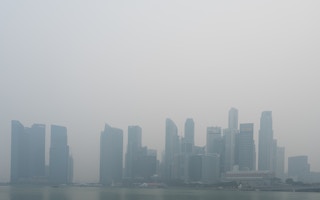Companies in Singapore can now get insurance for the haze.
To continue reading, subscribe to Eco‑Business.
There's something for everyone. We offer a range of subscription plans.
- Access our stories and receive our Insights Weekly newsletter with the free EB Member plan.
- Unlock unlimited access to our content and archive with EB Circle.
- Publish your content with EB Premium.
Zurich-based insurer Swiss Re has launched the first insurance product that specifically protects companies against the seasonal air pollution caused by burning peatlands in neighbouring Indonesia.
Payouts for Swiss Re’s HazeShield insurance are triggered when the air quality deteriorates beyond a certain threshold on the National Environment Agency’s Pollutant Standard Index (PSI)—there’s no need to give the insurance company evidence of losses or damages to make a claim.
Designed for natural disasters, HazeShield is a type of parametric insurance; pre-arranged sums are paid out when certain conditions are met. Swiss Re offers similar insurance to protect companies in Hong Kong against typhoons.
To prevent abuse of the scheme, for instance agribusiness firms buying insurance cover and then deliberately starting fires, companies in Indonesia and Singapore-based firms that maybe involved in slash-and-burn forestry in Indonesia are not eligible.
“
The financial consequences of a haze event can be severe, especially when businesses need to suspend
operations or close.Didier Bélot, chief executive officer, Southeast Asia, Swiss Re Corporate Solutions
Businesses in the city-state lost an estimated US$1.3 billion to the last two major haze events, in 1997 and 2015, with the tourism, hospitality, transport, and education sectors the most severely affected.
Only 30 per cent of losses were covered by insurance, according to data from Swiss Re Institute. HazeShield is designed to bridge this coverage gap, said Didier Bélot, Southeast Asia head at Swiss Re Corporate Solutions, the commercial insurance arm of Swiss Re.
Bélot told Eco-Business that while the years since 2015 have been relatively haze-free for Singapore, and improved fire control and peatland restoration efforts have helped reduce the likelihood of fires, there are factors affecting haze which are outside human control, such as El Niño, a climatic phenomenon that brings about particularly dry weather.
“The aim is to protect clients from unforeseeable extreme haze events,” said Bélot, pointing out that in February this year fires broke out in South Sumatra, West Kalimantan and Central Kalimantan, with hundreds of hectares of peatland burnt.
“Luckily, given the direction of the prevailing winds at the time and quick action from Indonesia, Singapore was largely spared the worst from these fires; however, this is a reminder that such events do flare up occasionally despite the best efforts to address them quickly,” he said.
Companies can get insured for either prolonged or extreme periods of haze, with a sliding scale of pricing and payout based on the PSI level. Singapore’s PSI level is based on the average levels of PM2.5—fine particulate matter that is most damaging to human health—as well as sulphur dioxide, nitrogen dioxide, ozone, and carbon monoxide.
The risk model used to create HazeShield was developed using a tool devised by Harvard and Columbia, the universities that in 2015 calculated the death toll of that year’s haze crisis in Indonesia.










